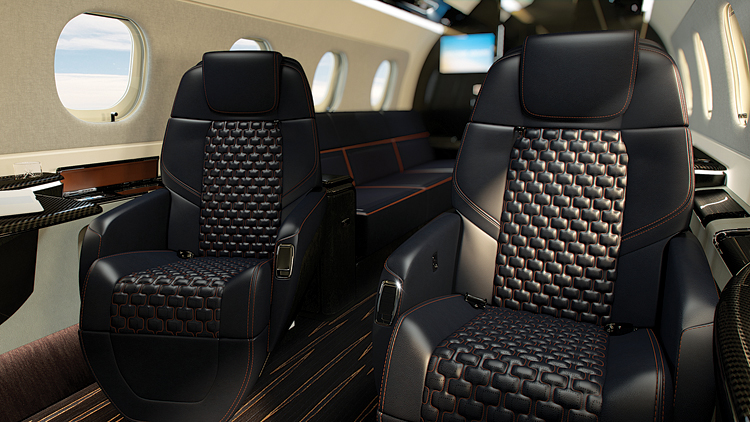Different by Design. Disruptive by Choice.

The Praetor 500 and the Praetor 600, announced by Embraer in October 2018, truly challenge the status quo in their respective classes with unmatched performance, especially in range capabilities with a full passenger count and all their luggage.
The Praetor 500 and Praetor 600 are aircraft certainly in keeping with their name. “Praetor” is most commonly interpreted as “leader, head, chief, or president.” Truly disruptive in their respective categories, they also redefine business aviation and lead the way in performance and comfort. They are disruptive aircraft for the entrepreneur, for the pioneer, for the innovator.
NEW COMFORT
The Praetor Jets will also debut an elegant new interior theme, which features carbon fiber materials, sophisticated stitching, and piano-black coloring. The new theme is called Bossa Nova and embodies the cool, stylish elegance of that famous style of Brazilian Jazz. A reinterpretation of Jazz, Bossa Nova is a musical genre that was created in Rio de Janeiro in the 1950s. The translation of Bossa Nova is “new trend,” thus a Bossa Nova Edition aircraft will be Embraer’s latest and most advanced interior, or the “newest trend” in stylish interiors. The custom Ipanema quilted style design on the seats is inspired by the famous sidewalks of Ipanema Beach in Rio de Janeiro, complemented by the tuxedo stitching and color accent details on the divan.
Sleek and futuristic upper tech panels run along the length of the cabin. Passengers can easily access in-flight information, lighting and climate controls and entertainment – everything for their convenience, at their fingertips.
The six-foot-tall, flat-floor cabin generously spoils its passengers with features engineered to deliver the utmost comfort. The Praetor Jets deliver the absolute best-in-class cabin altitude. Flying at 45,000 feet feels as pleasant as at a 5,800-foot altitude. From takeoff to 27,050 feet, cabin pressure is maintained at sea level. Everyone arrives at the destination refreshed and invigorated, ready to begin a new journey at their destination.
SUPERIOR PERFORMANCE
The Praetor 500 is the world’s fastest midsize jet, capable of delivering a remarkable, best in the category high-speed cruise of 463 KTAS (FL430, ISA, 4 pax at 200 lb each, mid-cruise weight). Customers can now reach more destinations, and faster, too.

The Praetor 500 dominates with its performance, delivering a nonstop range at long-range cruise of 3,250 nm (6,019 km) with a maximum endurance of nearly 8 hours. This is an impressive, commanding reach. In this remarkable aircraft, passengers can fly nonstop to faraway destinations, from Singapore to Beijing, or Dubai to Bangkok.
The Praetor 500 extends the passenger’s domain in other ways, too. This midsize aircraft can fly its maximum range from a 4,263-foot runway and can operate from runways as short as 3,000 feet. This performance capability gives passengers direct access to many more destinations, experiences and opportunities.
The disruptive Praetor 600 delivers a champion’s performance – a nonstop range at long-range cruise of 3,900 nm (7,223 km) with a maximum endurance of nearly 9 hours. In this commanding intercontinental aircraft, passengers can easily fly nonstop to far-away destinations, from London to New York or Dubai to Hong Kong. In fact, this is the only super-midsize jet that consistently delivers the London to New York flight mission.
This aircraft delivers a truly remarkable and unmatched runway performance. It can fly its maximum range from a 4,800-foot runway and can operate from a runway as short as 3,000 feet. Its enviable performance capability gives passengers direct access to many more destinations. Now, they can fly farther and into a wider variety of airports in the Praetor 600.
TOP-SHELF TECHNOLOGY
Embraer is the first and only OEM to bring full fly-by-wire to the midsize and super midsize categories, delivering a safer flight experience with full envelope protection during all stages of flight, a smoother flight experience, with full fly-by-wire’s active turbulence reduction capability, less pilot workload, less maintenance and better runway performance, enabling the aircraft to operate in more challenging airports.





